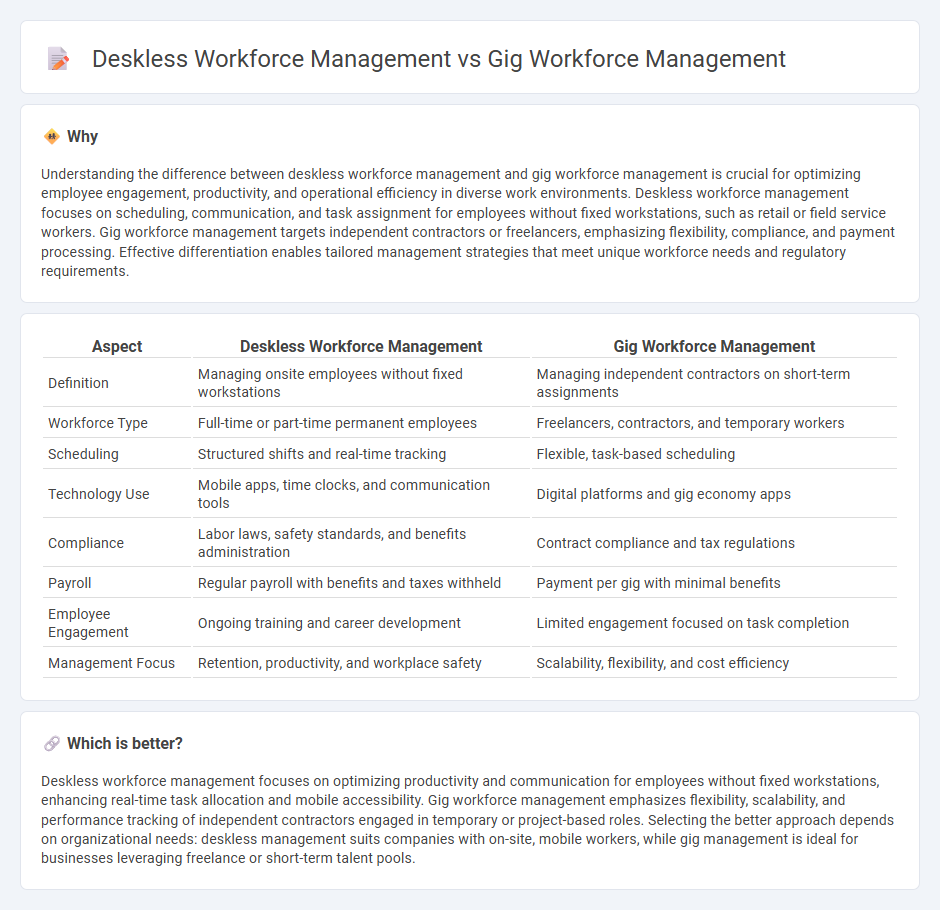
Deskless workforce management focuses on optimizing the productivity and engagement of employees who work outside traditional office environments, often involving mobile technology and real-time communication tools. Gig workforce management addresses the unique challenges of managing independent contractors and freelance workers, emphasizing flexibility, task allocation, and compliance with labor regulations. Discover how tailored management strategies can enhance efficiency and satisfaction in these distinct workforce models.
Why it is important
Understanding the difference between deskless workforce management and gig workforce management is crucial for optimizing employee engagement, productivity, and operational efficiency in diverse work environments. Deskless workforce management focuses on scheduling, communication, and task assignment for employees without fixed workstations, such as retail or field service workers. Gig workforce management targets independent contractors or freelancers, emphasizing flexibility, compliance, and payment processing. Effective differentiation enables tailored management strategies that meet unique workforce needs and regulatory requirements.
Comparison Table
| Aspect | Deskless Workforce Management | Gig Workforce Management |
|---|---|---|
| Definition | Managing onsite employees without fixed workstations | Managing independent contractors on short-term assignments |
| Workforce Type | Full-time or part-time permanent employees | Freelancers, contractors, and temporary workers |
| Scheduling | Structured shifts and real-time tracking | Flexible, task-based scheduling |
| Technology Use | Mobile apps, time clocks, and communication tools | Digital platforms and gig economy apps |
| Compliance | Labor laws, safety standards, and benefits administration | Contract compliance and tax regulations |
| Payroll | Regular payroll with benefits and taxes withheld | Payment per gig with minimal benefits |
| Employee Engagement | Ongoing training and career development | Limited engagement focused on task completion |
| Management Focus | Retention, productivity, and workplace safety | Scalability, flexibility, and cost efficiency |
Which is better?
Deskless workforce management focuses on optimizing productivity and communication for employees without fixed workstations, enhancing real-time task allocation and mobile accessibility. Gig workforce management emphasizes flexibility, scalability, and performance tracking of independent contractors engaged in temporary or project-based roles. Selecting the better approach depends on organizational needs: deskless management suits companies with on-site, mobile workers, while gig management is ideal for businesses leveraging freelance or short-term talent pools.
Connection
Deskless workforce management and gig workforce management intersect through their reliance on mobile technology and real-time communication platforms to coordinate dispersed employees. Both approaches emphasize flexibility, scheduling efficiency, and shift optimization to enhance productivity for non-traditional workers. Integrating these strategies improves workforce visibility, reduces labor costs, and drives operational agility across industries like retail, healthcare, and logistics.
Key Terms
Gig workforce management:
Gig workforce management centers on coordinating independent contractors and freelancers through digital platforms, optimizing scheduling, task allocation, and payment processing to enhance productivity and worker engagement. It leverages real-time data analytics and mobile technology to streamline communication and ensure compliance with labor regulations across diverse geographic locations. Explore detailed strategies and tools for effective gig workforce management to boost operational efficiency and worker satisfaction.
Contractual Engagement
Contractual engagement in gig workforce management emphasizes flexible, short-term contracts tailored to project-specific tasks, optimizing cost-efficiency and rapid deployment of talent. Deskless workforce management involves contracts that support ongoing roles with mobile, frontline employees, focusing on compliance, scheduling, and real-time communication. Explore how bespoke contractual strategies can enhance workforce agility and operational efficiency.
Task Allocation
Task allocation in gig workforce management centers around matching short-term, project-based tasks with available contractors, leveraging flexible platforms to optimize real-time assignments. Deskless workforce management focuses on scheduling and task distribution for on-site, mobile employees who operate without traditional office setups, emphasizing efficiency in communication and accountability through mobile solutions. Explore how tailored task allocation strategies drive productivity in both gig and deskless workforce environments.
Source and External Links
The Rise of Gig Workers and How to Manage Them - Outlines a comprehensive management checklist for gig workers, emphasizing hiring the right talent, clear contracts, effective communication tools, engagement, recognition, and integration with traditional employees for optimal performance.
Gig Workers: Hiring, Management, and More - Details best practices for managing gig workers, including clear communication of expectations, onboarding, timely payments, and providing regular feedback, all tailored to the independent nature of gig work.
The Gig Economy and Its Impact on Traditional Workforce Management - Explores how the gig economy transforms workforce management by shifting focus from permanent roles to flexible, project-based talent acquisition and requiring new approaches to performance management and accountability.
 dowidth.com
dowidth.com